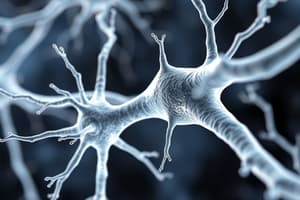Podcast
Questions and Answers
What are the common shapes of neuron cell bodies?
What are the common shapes of neuron cell bodies?
- Columnar and annular
- Cuboidal and discoidal
- Cylindrical and spherical
- Pyramidal and stellate (correct)
What is the primary function of dendrites in neurons?
What is the primary function of dendrites in neurons?
- Store genetic material
- Generate electrical impulses
- Receive information from other neurons (correct)
- Transmit information to other neurons
Which statement about axons is correct?
Which statement about axons is correct?
- Most axons are found only in the central nervous system
- Most axons are myelinated (correct)
- Most axons have no myelin covering
- Most axons contain ribosomes in their axoplasm
Which type of neuronal cell typically exhibits a single process?
Which type of neuronal cell typically exhibits a single process?
What role do glial cells serve in comparison to neurons?
What role do glial cells serve in comparison to neurons?
Where are axons in the peripheral nervous system covered that aids in recovery after damage?
Where are axons in the peripheral nervous system covered that aids in recovery after damage?
What is the approximate distance between membranes at a synapse?
What is the approximate distance between membranes at a synapse?
Which of these types of glial cells are primarily involved with support and repair in the nervous system?
Which of these types of glial cells are primarily involved with support and repair in the nervous system?
Which of the following is a neurotransmitter that LSD competes with at the synapse?
Which of the following is a neurotransmitter that LSD competes with at the synapse?
Flashcards
Neuron
Neuron
The basic structural and functional unit of the nervous system, responsible for transmitting information through electrical and chemical signals.
Cell Body (Soma)
Cell Body (Soma)
The central part of a neuron containing the nucleus and other essential organelles.
Dendrites
Dendrites
Branch-like extensions of a neuron that receive signals from other neurons.
Axon
Axon
Signup and view all the flashcards
Synapse
Synapse
Signup and view all the flashcards
Astrocyte
Astrocyte
Signup and view all the flashcards
Oligodendrocyte
Oligodendrocyte
Signup and view all the flashcards
Microglia
Microglia
Signup and view all the flashcards
Gap Junction
Gap Junction
Signup and view all the flashcards
Study Notes
Neurons
- The cerebral cortex contains approximately 20-25 billion neurons.
- Neuron shapes include pyramidal and stellate.
- Neuron cell bodies contain cytoplasm, a nucleus, and a nucleolus.
- Dendrites receive information from other neurons.
- Dendritic growth is observed in learning, with 45 orders noted. Individuals with Down's syndrome sometimes lack these higher-order dendrites.
- Most neurons possess a single axon, and their width ranges from 1 to 4 micrometers.
- Axons contain axoplasm, similar to cytoplasm but lacking ribosomes.
- Axons transmit signals to the end of the axon terminal, a common point for neurotransmitter release.
- Most axons are myelinated.
- Axons in the peripheral nervous system (PNS) have neurilema, aiding recovery from damage.
Neuronal Interfaces
- Gap junctions occur when membranes are less than 2 nanometers apart.
- Synapses are interfaces between axon terminals and dendrites/soma/axons; separated by about 10–15 nanometers.
- Many drugs interact with neurotransmitters or synapse processes. Examples include LSD competing with serotonin.
Neuron Process Classification
- Unipolar neurons have one process.
- Bipolar neurons have two processes.
- Multipolar neurons have three or more processes.
Glial Cells
- Glial cells outnumber neurons by approximately 5-10 times.
- Glial cell processes form a vast syncytium, a network mostly composed of gap junctions.
- Types of glial cells include astroglia, oligodendroglia, and microglia.
Studying That Suits You
Use AI to generate personalized quizzes and flashcards to suit your learning preferences.



